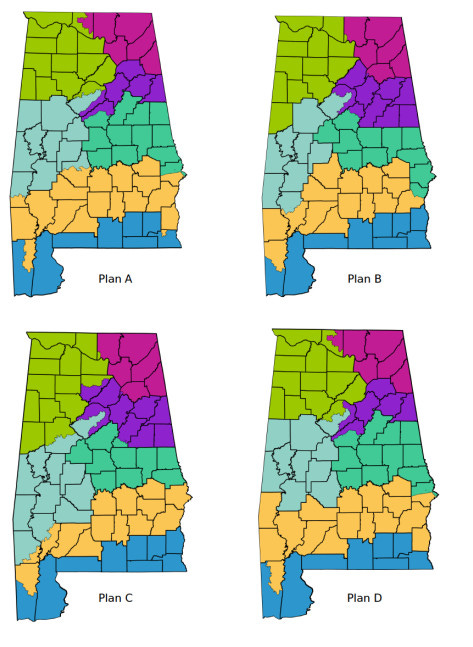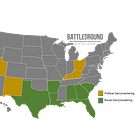SCOTUS Set to Weigh In On Racial Gerrymandering in Alabama
And this is just one of many cases to come...
UPDATE: SCOTUS has released their decision and has struck down the map above for racial gerrymandering. Continue reading for background information on the Supreme Court case.
Merrill v. Milligan: The Basics
Republicans in Alabama drew a map that packed most of Alabama’s Black population into a single district. That map was quickly challenged in court for racial gerrymandering: a federal court struck down Alabama’s new congressional districts and agreed that the new boundaries gave Black voters too few opportunities to elect a candidate of their choice. The court explicitly demanded that any acceptable alternatives “will need to include two districts in which Black voters either comprise a voting-age majority or something quite close to it.” This demand is pertinent due to the state’s historical, human geography.
African Americans makeup 27% of Alabama’s population. Accurate representation would mean that Black voters would have electoral control of two House seats in a seven-seat state. (2/7 = 28%, an almost perfect match to the size of the state’s current Black population). This population is also concentrated in the center of the state, meaning that there are several ways mapmakers could have created two compact, majority Black districts without having to split counties or stretch boundaries in odd ways to capture enough Black voters.

Alabama Attorney General Steve Marshall appealed the federal court decision to the US Supreme Court in hopes that the nation’s highest court will let the map stand as is. SCOTUS decided to take up the case and put a stay on the lower court’s ruling. This meant that Alabamans were forced to vote within potentially gerrymandered districts for the 2022 election.
How Might SCOTUS Rule?
SCOTUS could strike down the map…
If SCOTUS followed established precedent, justices would simply strike down the map for racial gerrymandering as plaintiffs have provided adequate evidence as outlined in previous gerrymandering cases. Thornburg v. Gingles provides the modern contours for litigating racial gerrymandering cases in federal court. That decision outlined that plaintiffs must provide evidence that not only shows that a fairer map is possible (shown above) they also must prove that the state has a “history of official discrimination” or “whether political campaigns have been characterized by overt or subtle racial appeals.” (And we’re taking about Alabama, both are pretty easy to substantiate in court.)
But today’s SCOTUS is one that has ignored established precedent to advance conservative ideology. As a result, most don’t expect Black Alabama voters to be delivered justice. Instead, voting rights advocates are bracing for the worst…
SCOTUS could neuter Sec. 2 of the Voting Rights Act…
The nightmare scenario is that SCOTUS takes aim at the Voting Rights Act, specifically Section 2 which definitively prohibits the “denial or abridgement of right to vote on account of race or color.” In their defense, the state of Alabama boldly claims that the Voting Rights Act “does not apply to challenges to single-member districts.” While SCOTUS is unlikely to accept this argument as this would eliminate the applicability of the Voting Rights Act altogether, justices did signal their openness to a different line of argument that results in the same effect. Elsewhere in their argument, lawyers representing the state of Alabama try to play a game of “gotcha” with plaintiffs by attempting to use Gingles against them:
“If Gingles is to serve any gatekeeping role, race cannot predominate in the districts a plaintiff proposes to satisfy that precondition.”
Their argument is that if Gingles says that race can’t be a predominate factor in drawing districts, then those alternative districts shown above are invalid because race was the predominate factor in their creation. To voting rights advocates this is an idiotic line of thinking: we’re being told to remedy racial discrimination with our eyes closed. While “race-blind” approaches to racial discrimination have been repeatedly shown to be ineffective, this is the exact kind of conservative fantasy that could be catnip to conservative SCOTUS justices. Although during arguments, justices have been signalling their want for a more limited decision that lets Alabama’s map stand without dramatically challenging or changing existing laws.
SCOTUS could just establish itself as kingmaker...
The fact that SCOTUS reinstated Alabama’s map for the 2022 elections shows their hand a little bit, almost no one seriously expects justices to strike down the map. (Reinstating a gerrymandered map just before an election only to strike it down afterwards only further erodes SCOTUS’s legitimacy.) However, in their questioning, many have noticed that justices seem to be searching for circumstantial evidence that would allow them to rule on Alabama’s map without touching the Voting Rights Act or redistricting law more broadly. Not only would this deliver conservatives’ desired outcome of upholding the map, it would also allow SCOTUS continued control as more gerrymandering cases are set to arrive. Both Louisiana and South Carolina have outstanding racial gerrymandering cases that may or may not be affected by the decision on Alabama. A narrow decision on Merrill v. Milligan would allow this conservative court to both continue its tradition of legislating from the bench while keeping an iron-grip over its authority on redistricting matters.
More From Battleground on Gerrymandering
Learn more about the upcoming Louisiana and South Carolina racial gerrymandering SCOTUS cases.




